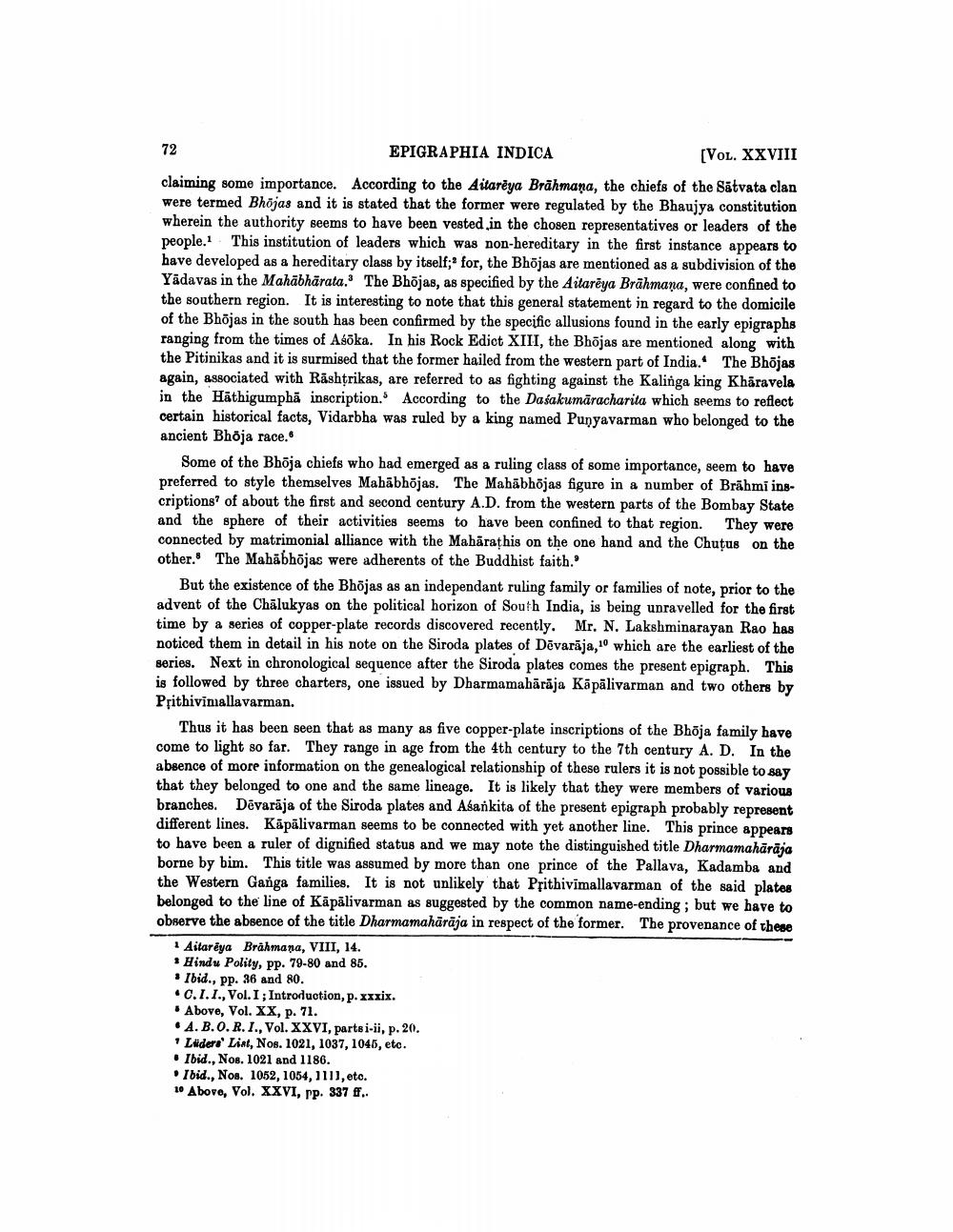________________
72
EPIGRAPHIA INDICA
[VOL. XXVIII claiming some importance. According to the Aitareya Brahmana, the chiefs of the Satvata clan were termed Bhojas and it is stated that the former were regulated by the Bhaujya constitution wherein the authority seems to have been vested in the chosen representatives or leaders of the people. This institution of leaders which was non-hereditary in the first instance appears to have developed as a hereditary class by itself; for, the Bhojas are mentioned as a subdivision of the Yadavas in the Mahabharata. The Bhojas, as specified by the Aitareya Brahmana, were confined to the southern region. It is interesting to note that this general statement in regard to the domicile of the Bhojas in the south has been confirmed by the specific allusions found in the early epigraphs ranging from the times of Asōka. In his Rock Edict XIII, the Bhojas are mentioned along with the Pitinikas and it is surmised that the former hailed from the western part of India. The Bhojas again, associated with Rashtrikas, are referred to as fighting against the Kalinga king Khāravela in the Hathigumpha inscription. According to the Daśakumaracharita which seems to reflect certain historical facts, Vidarbha was ruled by a king named Punyavarman who belonged to the ancient Bhoja race."
Some of the Bhōja chiefs who had emerged as a ruling class of some importance, seem to have preferred to style themselves Mahabhōjas. The Mahabhōjas figure in a number of Brahmi inscriptions of about the first and second century A.D. from the western parts of the Bombay State and the sphere of their activities seems to have been confined to that region. They were connected by matrimonial alliance with the Maharaṭhis on the one hand and the Chutus on the other. The Mahabhōjas were adherents of the Buddhist faith."
But the existence of the Bhojas as an independant ruling family or families of note, prior to the advent of the Chalukyas on the political horizon of South India, is being unravelled for the first time by a series of copper-plate records discovered recently. Mr. N. Lakshminarayan Rao has noticed them in detail in his note on the Siroda plates of Devaraja,10 which are the earliest of the series. Next in chronological sequence after the Siroda plates comes the present epigraph. This is followed by three charters, one issued by Dharmamahārāja Käpälivarman and two others by Prithivimallavarman.
Thus it has been seen that as many as five copper-plate inscriptions of the Bhoja family have come to light so far. They range in age from the 4th century to the 7th century A. D. In the absence of more information on the genealogical relationship of these rulers it is not possible to say that they belonged to one and the same lineage. It is likely that they were members of various branches. Devaraja of the Siroda plates and Asankita of the present epigraph probably represent different lines. Käpälivarman seems to be connected with yet another line. This prince appears to have been a ruler of dignified status and we may note the distinguished title Dharmamahārāja borne by bim. This title was assumed by more than one prince of the Pallava, Kadamba and the Western Ganga families. It is not unlikely that Prithivimallavarman of the said plates belonged to the line of Käpälivarman as suggested by the common name-ending; but we have to observe the absence of the title Dharmamahārāja in respect of the former. The provenance of these
Aitareya Brahmana, VIII, 14.
Hindu Polity, pp. 79-80 and 85.
Ibid., pp. 36 and 80.
C.I.I., Vol. I; Introduction, p. xxxix. Above, Vol. XX, p. 71.
A. B.O. R. I., Vol. XXVI, parts i-ii, p. 20.
"Lüders' List, Nos. 1021, 1037, 1045, etc. Ibid., Nos. 1021 and 1186.
Ibid., Nos. 1052, 1054, 1111, etc.
10 Above, Vol. XXVI, pp. 337 ff..




